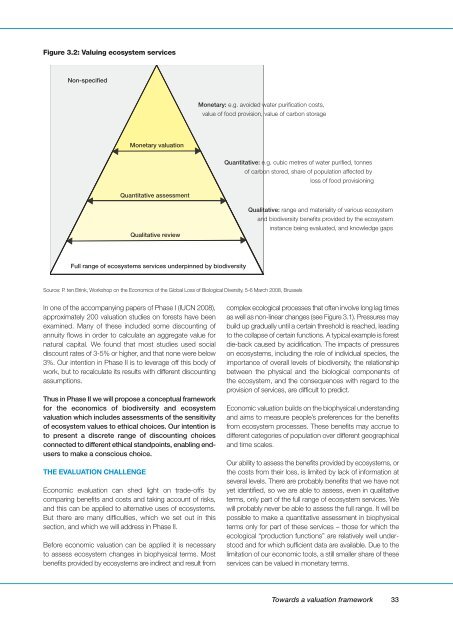Interim Report - TEEB
Interim Report - TEEB
Interim Report - TEEB
You also want an ePaper? Increase the reach of your titles
YUMPU automatically turns print PDFs into web optimized ePapers that Google loves.
Figure 3.2: Valuing ecosystem services<br />
Non-specified<br />
Monetary: e.g. avoided water purification costs,<br />
value of food provision, value of carbon storage<br />
Monetary valuation<br />
Quantitative: e.g. cubic metres of water purified, tonnes<br />
of carbon stored, share of population affected by<br />
loss of food provisioning<br />
Quantitative assessment<br />
Qualitative review<br />
Qualitative: range and materiality of various ecosystem<br />
and biodiversity benefits provided by the ecosystem<br />
instance being evaluated, and knowledge gaps<br />
Full range of ecosystems services underpinned by biodiversity<br />
Source: P. ten Brink, Workshop on the Economics of the Global Loss of Biological Diversity, 5-6 March 2008, Brussels<br />
In one of the accompanying papers of Phase I (IUCN 2008),<br />
approximately 200 valuation studies on forests have been<br />
examined. Many of these included some discounting of<br />
annuity flows in order to calculate an aggregate value for<br />
natural capital. We found that most studies used social<br />
discount rates of 3-5% or higher, and that none were below<br />
3%. Our intention in Phase II is to leverage off this body of<br />
work, but to recalculate its results with different discounting<br />
assumptions.<br />
Thus in Phase II we will propose a conceptual framework<br />
for the economics of biodiversity and ecosystem<br />
valuation which includes assessments of the sensitivity<br />
of ecosystem values to ethical choices. Our intention is<br />
to present a discrete range of discounting choices<br />
connected to different ethical standpoints, enabling endusers<br />
to make a conscious choice.<br />
THE EVALUATION CHALLENGE<br />
Economic evaluation can shed light on trade-offs by<br />
comparing benefits and costs and taking account of risks,<br />
and this can be applied to alternative uses of ecosystems.<br />
But there are many difficulties, which we set out in this<br />
section, and which we will address in Phase II.<br />
Before economic valuation can be applied it is necessary<br />
to assess ecosystem changes in biophysical terms. Most<br />
benefits provided by ecosystems are indirect and result from<br />
complex ecological processes that often involve long lag times<br />
as well as non-linear changes (see Figure 3.1). Pressures may<br />
build up gradually until a certain threshold is reached, leading<br />
to the collapse of certain functions. A typical example is forest<br />
die-back caused by acidification. The impacts of pressures<br />
on ecosystems, including the role of individual species, the<br />
importance of overall levels of biodiversity, the relationship<br />
between the physical and the biological components of<br />
the ecosystem, and the consequences with regard to the<br />
provision of services, are difficult to predict.<br />
Economic valuation builds on the biophysical understanding<br />
and aims to measure people’s preferences for the benefits<br />
from ecosystem processes. These benefits may accrue to<br />
different categories of population over different geographical<br />
and time scales.<br />
Our ability to assess the benefits provided by ecosystems, or<br />
the costs from their loss, is limited by lack of information at<br />
several levels. There are probably benefits that we have not<br />
yet identified, so we are able to assess, even in qualitative<br />
terms, only part of the full range of ecosystem services. We<br />
will probably never be able to assess the full range. It will be<br />
possible to make a quantitative assessment in biophysical<br />
terms only for part of these services – those for which the<br />
ecological “production functions” are relatively well understood<br />
and for which sufficient data are available. Due to the<br />
limitation of our economic tools, a still smaller share of these<br />
services can be valued in monetary terms.<br />
Towards a valuation framework<br />
33

















